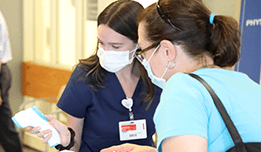Feeding a Small Army When Chaos Came To Town
Dec 3, 2012
NEW YORK
On Sunday, October 28th, as Hurricane Sandy moved toward the area, New York City officials suspended subway and city bus service, and ordered about 370,000 residents in low-lying areas to evacuate their homes. The storm made landfall in the area around 8 o'clock in the evening on Monday, October 29th. It was raining hard, winds were gusting to 81 mph, and the seas and rivers were rising. And, about a half hour later, flooding in a Con Edison substation knocked out power to most of Manhattan below midtown – including to some hospitals. (NewYork-Presbyterian did not lose power, but did accept some patients from other hospitals that did.)
Among the many obvious items hospital leaders had to worry about – flooding, electricity, gasoline – was the not so talked about problem of food. Large hospitals such as NewYork-Presbyterian feed thousands of people each day, which requires a reliable supply chain and stable workforce. Neither of which were easy to accomplish following Sandy.

Michael Williams
Raquel Rosen
Michael DeFilippo
"I was never worried about running out of food," said Michael Williams, the director of the Food and Nutrition Department at NewYork-Presbyterian/Weill Cornell Medical Center. Neither was Michael DeFilippo, the director at NewYork-Presbyterian/Columbia University Medical Center, or Raquel Rosen, the director at NewYork-Presbyterian's Allen Hospital. All had reorganized their deliveries to arrive a few days before Sandy. Even if no other deliveries could get through, they had enough food for at least four days.
In the days following Hurricane Sandy, the demand for patient meals remained about the same. Mr. William's team, for example, makes about 2,100 meals for patients each day. This went up slightly due to patients arriving from other hospitals, but the change was not dramatic. However, hospital employees were now working longer shifts and sometimes staying at the hospital because they had no way to travel to and from work. As a goodwill gesture, hospital leaders made cafeteria food free for all employees. Both factors increased demand.
Mr. William's team, who typically puts out 1,000 - 2,000 cafeteria meals a day for employees and visitors was now making 7,500 meals a day for them. Ms. Rosen's workers, who typically make about 500 meals a day for everyone, were now making about 1,900 meals for employees alone. Mr. DeFilippo's staff was now making about 5,800 cafeteria meals a day; up from its normal work load of about 2,000 meals a day.
Perhaps motivated by a personal sense of dedication or knowing that they were needed, some food service employees banded together. At Ms. Rosen's campus, those employees that had cars picked up those who did not. "We even had one gentleman who lives in Staten Island and somehow got to Manhattan and somehow walked 52 blocks to get here," she said.
Mr. DeFilippo, whose own house was flooded by six feet of water, arrived at his office on Sunday night and didn't leave until Wednesday morning. Mr. DeFilippo, like his management staff and some food service employees at each campus, stayed at the hospital, possibly bunking down near the very people that were keeping them there.
When talking with the directors, the primary feeling they display toward their employees is pride. "They understood how important their jobs were to have the patients, staff, and visitors fed. No one complained," said Ms. Rosen. "We have one employee who lost everything and still came to work on Wednesday so we had some very dedicated employees."
"They just rose to the occasion. I wouldn't say it was a pleasant experience because I don't think the hurricane was pleasant," said Mr. Williams. "But I was just so proud of everyone – just the way that they were able to pull together and really step up."
The word Mr. DeFilippo uses to describe his staff is "phenomenal." "If they hadn't done what they did, we would have had some issues," he said.



